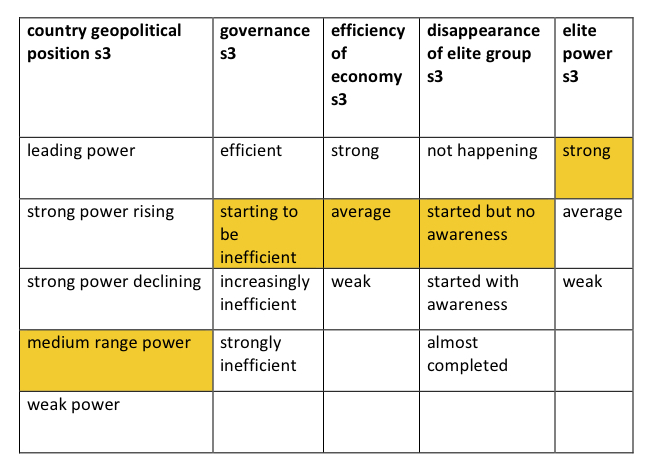The initial variables chosen to start building our scenario are the five most important variables of our model, according to Eigenvector centrality, as explained in the article “Revisiting influence analysis”.


We shall now choose values for each criterion.
Consistency is then checked, but only for the variables that are linked.
As we aim at finding a plausible and average, mild set of initial criteria, we shall start from the following set, which is also intuitively representative of the situation, real or perceived, in which many real world countries have found themselves for a couple of years.
Note that a complete set of scenarios depicting the whole range of possibles for the futures of the modern nation-state would need to cover all possible combinations of variables. We shall not address the way to handle this specific challenge of scenario-building here (we cover that in our on-site training courses).

We then verify that the chosen scenarios are consistent with the consistency matrix.
One of our aims is to obtain timelines that are as precise as possible for all our underlying processes and dynamics, as explained in Creating the model. However, most of the time, such a detailed scientific knowledge is still lacking (see also “Time in Strategic Foresight and Risk Management“. As a result, the timelines set are tentative. To underline this absence of certitude, we created a time that is specific to Everstate, Evertime. As explained in “Creating Evertime“, Evertime (in short EVT) mirrors our own time, but yet is also an ideal-type. It emphasises dynamics and sequences of events rather than specific dates for the onset of events and very precise durations.
However unsatisfactory this device when we want to depict our very real near future, this approach allows isolating the time component and focusing on sequences. As a result warning and steering of policies is eased. Each reader or user is free to adapt the temporal outline according to its convictions or methodology, waiting for better scientific knowledge.
We now have all the necessary material, as well as all the methodological background explanations to begin telling the story of Everstate, starting with setting the stage.


